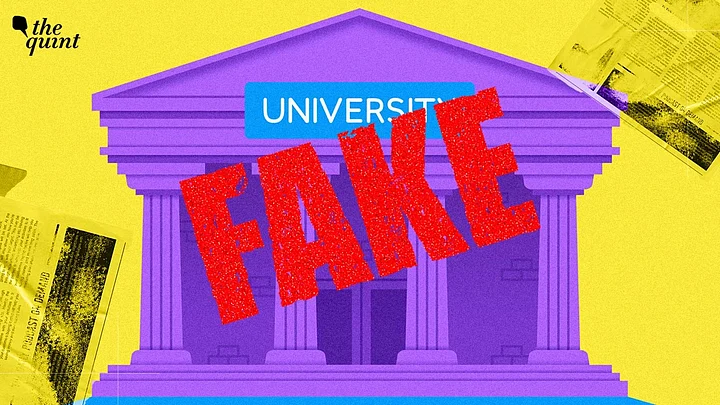Last week, the University Grants Commission (UGC) flagged 21 universities as ‘fake’ universities. Over the years, numerous ‘self-styled’ institutions have sprung up, trapping hundreds of students who spend time and money, only to end up without recognised degrees.
The regulatory body issued a list of 21 'self-styled, unrecognised' universities or institutions across India that are functioning in violation of the UGC Act 1956. A majority of them were located in Delhi-NCR, followed by Uttar Pradesh, West Bengal, and Odisha.
But with seemingly legitimate websites, how can students tell fake universities apart from the actual ones while taking admissions? The Quint speaks to Jyoti Arora, Principal of Mount Abu Public School in Delhi, Sauraveswar Sen, founder and chief mentor of Catalyst Learning Services, and Ritesh Jain, Faculty at AaptPrep – a coaching institute, who shed light on the issue.
What are fake universities?
According to UGC guidelines, only state, central/provincial, or deemed-to-be universities can grant degrees. The UGC Act further prohibits the use of the word ‘university’ by any institute unless it has UGC approval.
Those universities or institutions that function without this approval, and are granting degrees to their students that will not be officially recognised, are termed ‘fake universities'.
For instance, the Indian Institute of Alternative Medicine, which is featured in the UGC list, offers a number of courses, ranging from Diploma to Postgraduate courses. The Bachelor of Medicine and Bachelor of Surgery cost Rs 25,000 per year.
On its website, it says that it is an ‘Autonomous Organisation Under Govt of Arunachal Pradesh’.
How are students misled into believing that they are legitimate institutions?
Ritesh Jain: Some of these institutes or universities even use slightly altered logos of the regulatory authorities on their websites. While others use names very similar to existing universities, which can confuse students into applying for their courses.
One such instance was the Indian Institution of Science and Engineering in Delhi being declared a fake university this year. The name sounds oddly familiar because it bears a resemblance to the name Indian Institute of Science. Each of these institutes have campuses, classrooms, and a number of students enrolled.
How can a student tell if a university is legitimate?
Sauraveswar Sen: The first thing a student should look for is a separate section with the university affiliation. All websites might not display their accreditation and affiliation. However, all higher educational institutes in the country come under regulatory bodies such as the UGC or the All India Counsel for Technical Education (AICTE).
Any institute that uses the word ‘university’ has to be registered with the UGC. The UGC, on its website, has a section with a dropdown that shows the name of all the universities that come under it. The student can look for the university under that list as it is regularly updated.
If they are enrolling for technical – engineering – or management courses, they can refer to the AICTE website.
What about institutes that claim to be affiliated to universities?
Sauraveswar Sen: Now, one might find a college that says it is affiliated to Calcutta University. The student can trace the name of the college on the Calcutta University website and then find Calcutta University on the official UGC website - www.ugc.ac.in.
What are some of the other green flags to look for while applying?
Ritesh Jain: There is no one way to determine these things, and it can be tricky at times. One of the green flags a student can look for on the institutes’ website is its National Institutional Ranking Framework (NIRF), National Board of Accreditation (NBA), or National Assessment and Accreditation Council (NAAC) rankings. If the student suspects that the ranking on a website is fake, they can head to either of their websites and check if the institute in question is on their lists.
If they are still unsure, they can file a Right to Information (RTI) with the UGC to be certain.
How can instances of students getting admitted in such universities be reduced?
Jyoti Yadav: As a school principal, we ensure that when the career counselling sessions are taking place in school, students are informed that they are making the right decision. Before they apply to lesser-known institutes, we ask students and parents to check the UGC website or check the rankings.
What if the student has enrolled and then realises that the institute is fake?
Sauraveswar Sen: If a student, who has already been enrolled, realises that the institute is fake, they can take it to the Court under the Consumer Protection Act (2019) as long as they have some mode of official communication from the institute or university that proves to be untrue.
